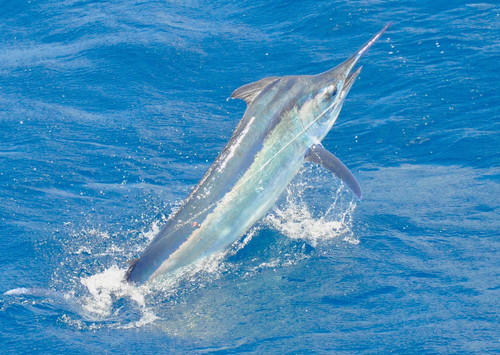
Black Marlin
The Bluefin Tuna, scientifically known as Thunnus thynnus, is a highly migratory species renowned for its size, speed, and commercial value. These fish are apex predators in the marine ecosystem and play a crucial role.
10 25 years
Lifespan
450 cm
Length
Near Threatened
Conservation Status
129 km/h
Swimming speed
Carnivorous
Diet
Highly Migratory, Pelagic Migration
Migration
Appearance Overview
The Bluefin Tuna is renowned for its large, streamlined body, built for speed and endurance in the open ocean.
Color
Dark metallic blue on top with a silvery underside
Fin arrangement
Two dorsal fins, the first depressible into a groove; a series of small finlets behind the second dorsal and anal fins
Body shape
Torpedo-shaped, designed for efficient swimming
Length
up to 10 feet (3 meters)
Weight
up to 1,500 lbs (680 kg)
Diet
Carnivorous, feeding on fish, squid, and crustaceans
Feeding Behavior
Uses speed to chase down prey, sometimes in coordinated schools
Social Behavior
Solitary, migratory
Commercial Relevance
High value in sushi markets
Conservation measures
Fishing quotas, marine protected areas
Status
Endangered
Threats
Overfishing, climate change, habitat loss
Habitat Distribution
Depth Range
0-900 meters
Geographic Range
Atlantic Ocean, Pacific Ocean, Mediterranean Sea
Preferred Environment
temperate waters, open ocean
Reproduction and Life Cycle
Breeding Habits
Spawns in warm waters, often near the Gulf of Mexico
Development Stages
Larvae hatch in plankton-rich waters and grow rapidly
Fecundity
Females can produce millions of eggs per season
Maturity Age
Matures at 4-8 years
Faqs about Black Marlin
Where are Bluefin tuna found?
Bluefin tuna are found in the Atlantic and Pacific Oceans, as well as the Mediterranean Sea.
How long do Bluefin tuna live?
Bluefin tuna can live up to 40 years.
Are Bluefin tuna used in sushi?
Yes, due to their high fat content and rich flavor, they are highly prized in sushi and sashimi.
What do Bluefin tuna eat?
Bluefin tuna primarily feed on smaller fish, squid, and crustaceans.
How far do Bluefin tuna migrate?
They are highly migratory, often traveling thousands of miles across oceans.
When do Bluefin tuna reach maturity?
They reach maturity at around 4-8 years of age.
How many eggs can a female Bluefin tuna release?
Females can release millions of eggs each spawning season.
What are the main threats to Bluefin tuna?
Overfishing is the primary threat, along with habitat degradation and climate change.
What conservation efforts are in place for Bluefin tuna?
Conservation efforts include fishing quotas, size limits, and protected areas.
How fast can Bluefin tuna swim?
Bluefin tuna can swim at speeds up to 43 mph (70 km/h).
Copyright @ Nature Style Limited. All Rights Reserved.
 English
English